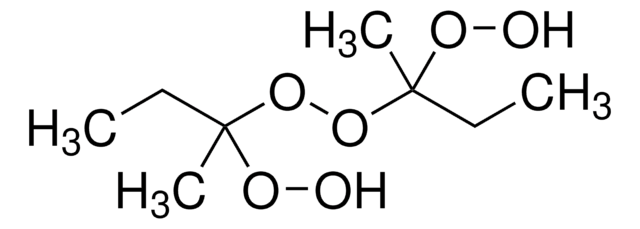495050
Luperox® DDM-9, 2-Butanone peroxide solution
~35 wt. % in 2,2,4-trimethyl-1,3-pentanediol diisobutyrate
Synonym(s):
2-Butanone peroxide solution, Methyl ethyl ketone peroxide solution
About This Item
Recommended Products
composition
available oxygen, 8-9%
Quality Level
reaction suitability
reagent type: oxidant
concentration
~35 wt. % in 2,2,4-trimethyl-1,3-pentanediol diisobutyrate
refractive index
n20/D 1.437
density
1 g/mL at 25 °C
storage temp.
2-8°C
SMILES string
CCC(C)(OO)OOC(C)(CC)OO
InChI
1S/C8H18O6/c1-5-7(3,11-9)13-14-8(4,6-2)12-10/h9-10H,5-6H2,1-4H3
InChI key
WFUGQJXVXHBTEM-UHFFFAOYSA-N
Looking for similar products? Visit Product Comparison Guide
Legal Information
Signal Word
Danger
Hazard Statements
Precautionary Statements
Hazard Classifications
Aquatic Chronic 3 - Eye Dam. 1 - Org. Perox. D - Repr. 2 - Skin Corr. 1B
Storage Class Code
5.2 - Organic peroxides and self-reacting hazardous materials
WGK
WGK 1
Flash Point(F)
Not applicable
Flash Point(C)
Not applicable
Certificates of Analysis (COA)
Search for Certificates of Analysis (COA) by entering the products Lot/Batch Number. Lot and Batch Numbers can be found on a product’s label following the words ‘Lot’ or ‘Batch’.
Already Own This Product?
Find documentation for the products that you have recently purchased in the Document Library.
Customers Also Viewed
Our team of scientists has experience in all areas of research including Life Science, Material Science, Chemical Synthesis, Chromatography, Analytical and many others.
Contact Technical Service











